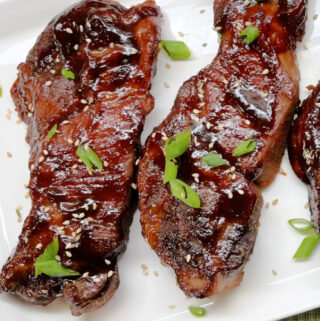
Country Style Asian BBQ Ribs
These Country Style Asian BBQ Ribs are the perfect tender and juicy boneless Asian ribs in the oven in just four easy steps.
Servings: 6 servings
Chef Alli
Save this Recipe
Ingredients
Ribs
- 3 lbs boneless country style pork ribs
Marinade
- 1/3 cup dark brown sugar
- 1/2 cup soy sauce, may use low sodium soy sauce
- 1/2 cup rice vinegar
- 1/2 cup ketchup
- 2 Tbs. lemon juice
- 1 tsp. garlic powder or granulated garlic
- 1/4 tsp. ground ginger
- 1 Tbs. sriracha, optional but delicious
- 1 tsp. kosher salt
Garnishments
- sliced scallions, as garnish
- sesame seeds, as garnish
Instructions
Marinate the Ribs
- Make the marinade by combining all the ingredients together in a bowl. Place all the ribs into a heavy-duty gallon bag; place into a deep bowl.
- Pour the prepared marinade into the bag with the ribs; seal the bag and gently massage to combine everything well. Place the bowl in the fridge; marinate the pork for at least 8 hours.
Bake the Ribs
- When you are ready to cook the ribs, remove them refrigeration. Remove the ribs from the marinade, patting each one dry. Let the ribs rest for 30 minutes before baking them. **Reserve the marinade. You'll be cooking it down into a nice thick sauce later.
- Preheat the oven to 300 degrees F. Wrap two large, rimmed baking sheets with heavy-duty foil.
- Place the ribs onto one of the foil-lined baking sheets; cover with foil.
- Bake the ribs, covered, for 1 1/2 hours, or just until they are starting to become fork-tender.
- Meanwhile, while the ribs bake, place the reserved marinade into a saucepan over medium heat; bring to a boil. Simmer the marinade until thickened and reduced, about 4-5 minutes; remove from the heat and reserve.
Sauce the Ribs
- When the ribs are just about fork-tender, remove them from the oven and uncover. Transfer the ribs from the baking sheet (it will likely be full of grease after cooking the ribs) to the second foil-lined baking sheet that you prepared earlier.
- Using a silicone basting brush, liberally slather the ribs with the prepared sauce.
- Continue to bake the ribs, uncovered this time, for an additional 25-30 minutes or until the ribs are very fork-tender and caramelized.
Serve the Ribs
- Garnish with scallions and sesame seeds, if using. Serve the ribs with extra warm sauce on the side, as desired.
Notes
- Covering your rimmed baking sheets with foil before baking the ribs makes for super easy clean up. Washing greasy baking sheets is never fun.
- Don’t worry if the ribs look pretty “ugly” after the first go round in the oven covered with foil. This is because you haven’t added the sauce yet. Don’t worry….keep going! The final step of the recipe is when you brush on the sauce and let it caramelize – this is where all the magic happens!
- Rest the ribs after removing them from the marinade before baking them, as the recipe directs. This give the meat a bit of time to let the chill from refrigeration escape so the ribs can cook more evenly. It makes them taste better too!
- Be sure to place the sealed bag of ribs and marinade into a bowl before placing them into refrigeration. This way if there’s a leak in your bag, the marinade only fills the bowl, not your fridge!
- In this recipe, you will be converting the marinade into a sauce by simmering it until nicely thickened. This process is also what makes the marinade safe to eat since simmering it kills any bacteria that may come from the raw pork. Otherwise, the marinade would need to be safely discarded.
- If you prefer to have lots of extra sauce for serving with the cooked ribs, you can double the ingredients for the sauce. It may take a few extra minutes of simmering since there’s more volume in the sauce pan when you double the ingredients.
- Always test meat for tenderness using a fork. The tip of a knife will easily insert itself, giving false impression that meat is tender. If the dull tines of a fork slide right into a piece of meat, you know it’s truly tender and ready to eat. When the ribs are very fork-tender when tested, they will be right around 180 degrees F. at the center of each one when tested with an instant-read meat thermometer.
- When you bake the ribs, there will be a lot of fat and juice that accumulates in the baking sheet. It’s very easy to lift the ribs from all this excess and place them onto another baking sheet to then brush them with the sauce and finish baking.
- I like to pour that rendered fat (the grease) into a big jar that I keep in the fridge for my dogs and then I add a small amount at a time to their dry dog food. They go crazy for it!
- Boneless country-style ribs also make great meat for kabobs. Just cut each rib into chunks and place them onto skewers to make the kabobs. Be sure you leave space between each hunk of pork so it can cook more quickly and evenly.
Nutrition
Calories: 366kcalCarbohydrates: 19gProtein: 31gFat: 18gSaturated Fat: 4gTrans Fat: 1gCholesterol: 109mgSodium: 1734mgPotassium: 610mgFiber: 1gSugar: 17gVitamin A: 118IUVitamin C: 4mgCalcium: 52mgIron: 2mg
Tried this recipe?Let us know how it was!